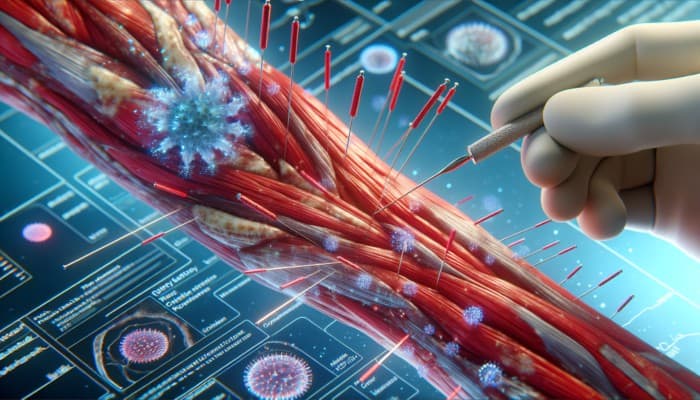Effective Acupuncture Strategies for Treating Tendonitis
Comprehensive Overview of Tendonitis: Causes and Symptoms

Acupuncture for Tendonitis Relief: Tendonitis is a painful inflammatory condition primarily affecting the tendons, the resilient fibrous tissues that connect muscles to bones. It typically arises due to repetitive strain, overuse injuries, or acute trauma and can impact individuals across various professions. Athletes, manual laborers, and even individuals engaged in sedentary office work can develop tendonitis due to the strain associated with their activities. Some prevalent forms of this condition include tennis elbow, Achilles tendonitis, and rotator cuff tendonitis.
Patients often experience localized pain, tenderness, swelling surrounding the affected joint, and stiffness during movement. This limitation can severely hinder daily activities and quality of life. Early recognition of these symptoms is crucial for timely intervention and recovery. If you find yourself experiencing these signs, seeking professional guidance on acupuncture for tendonitis treatment could be an invaluable step toward relief.
Exploring the Mechanisms of Acupuncture
Acupuncture is an ancient therapeutic practice deeply rooted in Traditional Chinese Medicine (TCM) that involves the insertion of ultra-fine needles into precise points on the body. From a Western medical standpoint, acupuncture is thought to activate the nervous system, promoting the release of neurotransmitters and hormones that significantly alleviate pain and reduce inflammation.
When it comes to tendonitis, acupuncture can provide noteworthy benefits. By harmonizing the body's energy, or Qi, acupuncture aids in restoring normal function and alleviating discomfort. The strategic placement of needles can initiate the body's natural healing processes, improving blood circulation to the affected area, which is crucial for recovery. This integrative approach—balancing energy while promoting healing—renders acupuncture a compelling treatment option for those contending with tendonitis.
Scientific Studies Highlighting Acupuncture's Efficacy
A multitude of studies have underscored the effectiveness of acupuncture for tendonitis treatment. For instance, a systematic review in a respected medical journal revealed that patients who underwent acupuncture for various tendonitis conditions experienced notable pain relief compared to those who did not. Further clinical trials have confirmed that acupuncture reduces inflammation and accelerates healing times.
Researchers highlight its effectiveness in enhancing local blood circulation, an essential factor in tendon recovery. A thorough examination of these studies indicates that acupuncture is not merely an alternative therapy but a scientifically validated approach to managing tendonitis effectively.
Utilizing Acupuncture to Relieve Tendonitis Pain

Identifying and Targeting Key Trigger Points for Relief
Acupuncturists possess the expertise to pinpoint specific trigger points associated with tendonitis. These points are linked to tension and discomfort that often accumulate due to repetitive movements or excessive strain. By inserting needles into these targeted areas, acupuncturists can effectively diminish inflammation and pain.
For instance, in tennis elbow, needles may be strategically placed around the elbow joint and in the forearm to alleviate tension and stimulate the healing process. This focused treatment addresses the immediate symptoms and rectifies underlying issues contributing to the discomfort, such as muscle imbalances or poor posture.
Ultimately, this targeted approach can lead to significant pain relief and restoration of function, enabling patients to resume their daily activities unhindered by the debilitating effects of tendonitis.
Enhancing Blood Circulation and Healing Through Acupuncture
One of the primary advantages of acupuncture is its ability to enhance blood circulation throughout the body. Improved blood flow is vital for healing, as it delivers essential nutrients and oxygen to damaged tissues. When treating tendonitis, acupuncture significantly boosts circulation to the affected tendons, which can expedite recovery.
Research indicates that enhanced circulation alleviates pain and facilitates the body's innate repair mechanisms. As tendons recover more swiftly, patients often notice a decrease in stiffness and an increase in mobility, paving the way for a more active lifestyle following treatment. This underscores the importance of incorporating acupuncture for tendonitis treatment as a critical element of a comprehensive recovery strategy.
Integrating Acupuncture with Complementary Therapies

Acupuncture can be seamlessly combined with other therapeutic modalities for a holistic approach to managing tendonitis. For example, acupuncture's pain-relieving effects can significantly augment physical therapy, enabling patients to engage more fully in their rehabilitation exercises.
Moreover, combining acupuncture with medication can optimize pain management strategies. While medications may offer immediate relief, acupuncture addresses the root causes of discomfort, thereby preventing recurrences. This synergistic approach enhances overall outcomes and empowers patients to manage their tendon health proactively.
Tailored Acupuncture Techniques for Various Types of Tendonitis
Effectively Treating Tennis Elbow with Acupuncture
Tennis elbow, clinically known as lateral epicondylitis, is characterized by pain on the outer elbow due to repetitive overuse. Acupuncture techniques to treat this condition often involve placing needles along the forearm, elbow, and shoulder.
Research supports the efficacy of specific acupuncture points, such as LI10 and LI11, in alleviating pain associated with tennis elbow. Acupuncturists can effectively reduce inflammation and promote healing in the affected tendons by stimulating these key points, providing rapid relief and enhancing functional outcomes.
Patients frequently report significant decreases in pain levels after just a few treatment sessions, making acupuncture a desirable adjunctive option for individuals seeking to complement conventional therapeutic methods.
Utilizing Acupuncture for Effective Management of Achilles Tendonitis
Achilles tendonitis can be painful and limiting, particularly for athletes. Acupuncture provides a unique and practical approach to managing this type of tendonitis. Acupuncturists can successfully reduce inflammation by targeting specific points around the ankle and calf muscles while enhancing circulation to the affected area.
Common acupuncture points such as GB34 and BL57 alleviate symptoms associated with Achilles tendonitis. Clinical evidence substantiates acupuncture's role in improving flexibility and reducing pain in the Achilles tendon, ultimately enabling individuals to resume their athletic pursuits sooner.
Moreover, acupuncture can help mitigate the risk of recurrence by addressing potential biomechanical factors that may have contributed to the initial development of the tendonitis.
Managing Pain and Enhancing Mobility in Rotator Cuff Tendonitis
Rotator cuff tendonitis is a common ailment characterized by pain and restricted mobility in the shoulder region. Acupuncture is instrumental in managing this condition by targeting specific points around the shoulder and upper back to relieve tension and facilitate healing.
Key acupuncture points, such as SI9 and LI15, are often employed to alleviate shoulder pain effectively. This targeted treatment approach can improve range of motion and reduce stiffness, enabling patients to participate in daily activities without discomfort.
Incorporating acupuncture into a comprehensive rehabilitation program can significantly enhance recovery outcomes, making it a valuable resource for anyone grappling with rotator cuff tendonitis.
Your Guide to an Acupuncture Session for Tendonitis Treatment
Initial Consultation and Comprehensive Health Assessment
Your journey into acupuncture for tendonitis treatment begins with an initial consultation. During this crucial visit, the acupuncturist will conduct an in-depth health history assessment, discussing your symptoms, lifestyle, and any previous treatments you may have undergone. This thorough evaluation is vital in determining the most effective course of action tailored to your needs.
Be prepared to answer questions regarding your pain levels, the duration of your symptoms, and any factors that might aggravate your condition. This detailed information is essential for developing a personalized treatment plan that addresses your situation and promotes optimal healing.
A Step-by-Step Explanation of the Acupuncture Procedure
During an acupuncture session, you will lie comfortably while the acupuncturist prepares to insert needles into designated points on your body. These needles are exceptionally thin, and most patients report minimal to no discomfort during the insertion process.
The acupuncturist may leave the needles in place for approximately 20 to 30 minutes. During this time, you may experience relaxation and warmth as your body responds to the treatment, facilitating healing and pain relief.
Some patients may feel slightly groggy after the session, while others may experience a burst of energy. Communicating any sensations you experience during the treatment to your acupuncturist is crucial, as this feedback can help tailor adjustments for future sessions.
Post-Treatment Care and Importance of Follow-Up Sessions
After an acupuncture session, mild soreness or tenderness in the treated areas is common. This sensation is typically slight and subsides fairly quickly. Your acupuncturist may provide specific aftercare instructions, such as avoiding strenuous activities for a brief period or applying heat to the treated area to enhance relaxation.
Follow-up sessions are essential for monitoring progress and adjusting the treatment plan. Consistent treatments can result in cumulative benefits, significantly improving your tendonitis symptoms.
Choosing the Right Acupuncturist for Effective Tendonitis Treatment
Essential Qualifications and Certifications to Consider
When seeking an acupuncturist to address your tendonitis, evaluating their qualifications and certifications is critical. Look for practitioners who have completed accredited acupuncture programs and hold the necessary licenses in their regions.
In many jurisdictions, acupuncturists are required to pass stringent examinations to practice. Additionally, checking for memberships in professional organizations, such as the National Certification Commission for Acupuncture and Oriental Medicine (NCCAOM), can further assure you of their expertise.
A well-qualified acupuncturist will possess a strong understanding of anatomy and physiology, particularly in relation to musculoskeletal issues like tendonitis, ensuring you receive the highest quality of care.
Inquiries to Make Before Commencing Treatment
Before embarking on your acupuncture journey, asking potential practitioners several important questions is prudent. Inquire about their experience treating tendonitis specifically and their overall approach to treatment.
Ask about the typical number of sessions they recommend for your condition and the methods they use to measure progress. Additionally, it can be beneficial to discuss any supplementary therapies they may suggest in conjunction with acupuncture. Clarifying the treatment plan can alleviate concerns and set realistic expectations for your healing journey.
Value of Patient Reviews and Testimonials
Patient reviews and testimonials can provide invaluable insights into an acupuncturist's effectiveness. Seek online reviews on platforms like Google, Yelp, or specialized healthcare websites.
Positive feedback regarding pain relief and overall satisfaction can indicate a practitioner's skill level and quality of patient care. If possible, contact former patients to gather firsthand accounts of their experiences, as this can significantly inform your decision-making process.
Integrating Lifestyle and Home Care Strategies to Enhance Acupuncture Benefits
Practical Exercises and Stretches for Relief from Tendonitis
Incorporating targeted exercises and stretches into your daily routine can significantly amplify the benefits of acupuncture for tendonitis treatment. Gentle stretches focusing on the affected area can help maintain flexibility, while strengthening exercises can support the surrounding muscles and alleviate strain on the tendons.
For instance, wrist flexor and extensor stretches in tennis elbow can effectively relieve tension. Similarly, for Achilles tendonitis, calf stretches and range-of-motion exercises can assist in maintaining flexibility and mitigating stiffness. Always consult with your acupuncturist or a physical therapist to ensure the exercises suit your specific condition.
Nutrition and Supplements to Support Tendon Health
Maintaining a balanced diet rich in anti-inflammatory foods can significantly enhance tendon health and recovery. Incorporating omega-3 fatty acids found in fish and flaxseeds and antioxidants from various fruits and vegetables can help combat inflammation effectively.
Additionally, supplements such as collagen, glucosamine, and turmeric may prove beneficial in promoting tendon health and alleviating pain. Always discuss any dietary changes or supplements with your healthcare provider to ensure they are appropriate for your treatment plan.
Strategies for Preventing Tendonitis Recurrence
Adopting lifestyle modifications that support tendon health is essential to preventing the recurrence of tendonitis after acupuncture treatment. Proper warm-up and cool-down routines during physical activities can significantly reduce the risk of strain and injury.
Moreover, focusing on ergonomic practices at work and during sports activities can alleviate unnecessary pressure on your tendons. Regular engagement in strength training and flexibility exercises will fortify the muscles surrounding your tendons, enhancing their resilience against injuries.
A proactive approach to maintaining your tendon health, in conjunction with acupuncture, can empower you to lead an active and pain-free lifestyle.
Frequently Asked Questions about Acupuncture and Tendonitis
What does acupuncture for tendonitis treatment entail?
Acupuncture for tendonitis treatment involves inserting thin needles into specific points to alleviate pain and promote healing in the affected tendons.
How many acupuncture sessions are typically required for tendonitis?
The number of sessions needed varies from person to person, but many patients notice improvement within 3 to 6 sessions, depending on the severity of their condition.
Is the acupuncture process painful?
Most individuals report minimal discomfort during acupuncture, as the needles are extremely thin. Some may experience a slight tingling or warm sensation.
Can acupuncture be effectively combined with other treatments?
Yes, acupuncture can synergistically complement other treatments such as physical therapy, medication, or massage therapy for comprehensive management of tendonitis.
Are there any side effects associated with acupuncture?
While generally considered safe, some individuals may experience minor soreness or bruising at the needle sites. Serious side effects are rare when a qualified practitioner performs acupuncture.
How does acupuncture help reduce inflammation?
Acupuncture aids in reducing inflammation by enhancing blood circulation and stimulating the release of anti-inflammatory chemicals within the body.
Can I engage in exercises after an acupuncture session?
Follow your acupuncturist's recommendations. Light stretching is generally encouraged, while strenuous activities should be avoided immediately following treatment.
What is the typical duration of an acupuncture session?
An acupuncture session lasts 30 to 60 minutes, depending on the treatment plan and individual patient needs.
What type of clothing should I wear to an acupuncture appointment?
Wear loose, comfortable clothing that allows easy access to the treatment areas. This facilitates the acupuncture process.
How can I find a qualified acupuncturist?
Look for licensed practitioners with experience treating tendonitis. Consider checking reviews or asking for referrals to ensure you receive quality care.
























8 Comments
Your comprehensive overview of tendonitis clearly highlights not only the physical challenges this condition presents but also its far-reaching implications on daily life and productivity. Speaking from personal experience, I can attest to the debilitating nature of tendonitis, having dealt with both tennis elbow and Achilles tendonitis at different points in my life. Each time it felt as though I was not only sidelined physically but also mentally, grappling with frustration and limitations during activities I once enjoyed.
It’s really interesting to hear about your experiences with both tennis elbow and Achilles tendonitis. It sounds incredibly frustrating to face those limitations, especially when you’re being sidelined from activities you love. I can imagine how that not only impacts your physical capabilities but also creates a mental struggle, as you said.
Your exploration of tendonitis really resonates, especially given how prevalent it has become across various professions. I’ve personally dealt with tendonitis from hours spent typing at my desk job. The stiffness and discomfort truly impact everyday tasks.
It’s interesting how common tendonitis has become, especially with the lifestyle many of us lead. Spending hours at a desk can really take its toll, and it makes sense that stiffness and discomfort seep into everyday activities. I’ve seen how it affects people personally, too; when your hands or wrists are sore, even at home, simple things can feel challenging.
It’s interesting how common tendonitis has become, isn’t it? Your experience with it from typing really highlights just how our daily routines can take a toll on our bodies. I can definitely relate—spending long hours on the computer can lead to some serious discomfort. It’s so easy to forget about posture and take those short breaks when you’re focused on work.
This overview on acupuncture strategies for treating tendonitis is quite enlightening. As someone who has dealt with Achilles tendonitis after years of running, I can personally attest to how debilitating this condition can be. It’s interesting to see how acupuncture offers a holistic approach to managing inflammation and pain – something that often gets neglected when discussing conventional treatments.
It’s fascinating to delve into the world of tendonitis and how acupuncture can play a transformative role in alleviating its discomfort. This condition, as you’ve outlined, affects so many of us across different walks of life, often sneaking up on individuals who might not even realize the underlying strain they’re putting on their bodies through everyday activities. I’ll be the first to admit that I hadn’t given much thought to how repetitive motions in my own job could contribute to something as debilitating as tendonitis until I faced a similar challenge.
Your exploration of tendonitis and its treatment through acupuncture resonates with many who face this frustrating condition. I’ve personally experienced the debilitating effects of Achilles tendonitis after intensive running, which made me appreciate the need for effective and holistic treatment options.